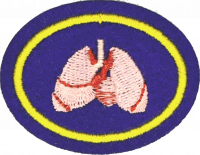Difference between revisions of "AY Honors/Cardiopulmonary System/Requirements"
(+ Cardiopulmonary System Requirements Page from the Australian Union Conference) |
(+ Cardiopulmonary System Requirements Page from the Australian Union Conference) |
||
| Line 71: | Line 71: | ||
:<b>h. <section begin=req6h /><noinclude><translate></noinclude>Bradypnoea | :<b>h. <section begin=req6h /><noinclude><translate></noinclude>Bradypnoea | ||
<noinclude></translate></noinclude><section end=req6h /></b> | <noinclude></translate></noinclude><section end=req6h /></b> | ||
| − | |||
| − | |||
| − | |||
:<b>i. <section begin=req6i /><noinclude><translate></noinclude>Hyperventilation | :<b>i. <section begin=req6i /><noinclude><translate></noinclude>Hyperventilation | ||
Latest revision as of 00:17, 18 September 2023
1. What makes up the respiratory tract?
2. What muscles are involved in breathing?
3. Explain how changes in pressure help us breathe in and out. How do these pressure changes happen?
4. What can make it hard for air to flow in our lungs? How can problems in the shape of our lungs or sicknesses cause this?
5. Demonstrate your knowledge and understanding of the following medical prefixes and suffixes by giving their meaning:
- a. Hypo-
- b. Hyper-
- c. A- (an-)
- d. Tachye-
- e. Brady-
- f. Pneumo-
- g. -pnoea
- h. -itis
- i. -thoracic
6. Choose seven medical terms from the list below and give their meanings.
- a. Eupnoea
- b. Dyspnoea
- c. Apnoea
- d. Hyperpnoea
- e. Hypopnoea
- f. Orthopnoea
- g. Tachypnoea
- h. Bradypnoea
- i. Hyperventilation
- j. Hypoventilation
- k. Respiratory arrest
- l. Dead space
7. Choose three lung problems from the list. Tell how they make it hard for someone to breathe and what might happen if they don’t get treated.
- a. Pneumothorax
- b. Asthma
- c. Pulmonary embolism
- d. COVID-19
- e. Pneumonia
- f. Tuberculosis
- g. Lung cancer
- h. Chronic Obstructive Pulmonary Disease (COPD)
- i. Pleural effusion
- j. Bronchiectasis
8. Safely participate in a dissection of a lung, observing and discussing the following:
- a. Where in the lung respiration takes place
- b. The reason for different textures being present in the lung (e.g., lung tissue vs. trachea)
- c. The change of airway size based on location
- d. How airway size changes based on its location
- e. How pathologies from requirement 7 interact with the lung tissue
9. Discuss how Paul’s message in 1 Corinthians 12 can relate to how the heart and lungs operate together.



